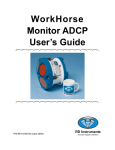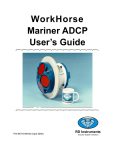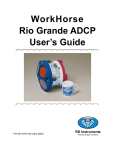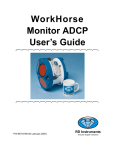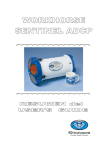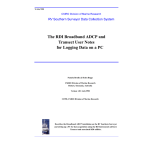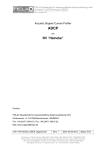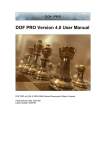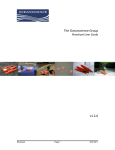Download WorkHorse Sentinel User's Guide
Transcript
WorkHorse Sentinel ADCP User’s Guide P/N 957-6163-00 (April 2005) RD Instruments Acoustic Doppler Solutions Table of Contents 1 Introduction....................................................................................................................................... 1 2 WorkHorse Sentinel ADCP Applications........................................................................................ 2 3 System Overview .............................................................................................................................. 4 3.1 3.2 3.3 3.4 3.5 4 Sentinel ADCP Overview ....................................................................................................................4 I/O Cable Overview.............................................................................................................................6 Battery Pack Overview........................................................................................................................7 Flash Memory Card Overview.............................................................................................................9 Spare Parts .........................................................................................................................................9 WorkHorse Care................................................................................................................................ 9 4.1 4.2 4.3 5 General Handling Guidelines ............................................................................................................10 Assembly Guidelines ........................................................................................................................11 Deployment Guidelines .....................................................................................................................11 Setup the WorkHorse Sentinel ADCP........................................................................................... 12 5.1 5.2 6 Serial Communication .......................................................................................................................12 What if the WorkHorse Does Not Respond.......................................................................................13 Software........................................................................................................................................... 13 6.1 6.2 6.3 6.4 7 System Requirements.......................................................................................................................14 Software Installation..........................................................................................................................14 WorkHorse Software Philosophy ......................................................................................................14 File Naming Conventions ..................................................................................................................15 Batteries and Power ....................................................................................................................... 16 7.1 7.2 7.3 7.4 7.5 8 AC Adapter .......................................................................................................................................16 Alkaline Battery Pack Capacity .........................................................................................................16 External Battery Pack .......................................................................................................................17 Bench-Top Battery Power Requirements..........................................................................................17 Operation Modes ..............................................................................................................................17 Testing Your WorkHorse................................................................................................................ 18 9 Compass Calibration...................................................................................................................... 19 7.1 7.2 7.3 10 Preparing for Calibration ...................................................................................................................19 Compass Calibration Verification ......................................................................................................20 Compass Calibration Procedure .......................................................................................................21 Internal Pressure Sensor ............................................................................................................... 23 10.1 11 Deployment Guide .......................................................................................................................... 24 11.1 11.2 11.3 11.3.1 11.3.2 11.3.3 11.3.4 11.3.5 11.4 11.5 11.6 11.7 12 Pressure Sensor Maintenance..........................................................................................................23 Deployment Checklist .......................................................................................................................24 Prepare the ADCP for Deployment ...................................................................................................26 Use the Deployment Wizard .............................................................................................................27 Plan the Deployment.........................................................................................................................28 Set the ADCP’s Clock .......................................................................................................................29 Verify the Compass...........................................................................................................................30 Run the Pre-Deployment Tests.........................................................................................................31 Send the Commands ........................................................................................................................32 Deploy and Recover the ADCP.........................................................................................................33 Recover the Data ..............................................................................................................................34 Verify and View the Data ..................................................................................................................35 Erase the Recorder ...........................................................................................................................36 Backing Up Data ............................................................................................................................. 36 13 Reviewing the Data......................................................................................................................... 37 13.1 13.2 13.3 'Where' was the Data? ......................................................................................................................37 'When' was the Data? .......................................................................................................................37 'What' is the Data? ............................................................................................................................37 14 A Few Principles of Operation ...................................................................................................... 38 15 Technical Support .......................................................................................................................... 39 List of Figures Figure 1. Figure 2. Figure 3. Figure 4. Figure 5. Figure 6. Figure 7. Figure 8. Figure 9. Figure 10. Figure 11. Figure 12. Figure 13. Figure 14. Figure 15. Figure 16. Figure 17. Figure 18. Figure 19. Figure 20. Figure 21. Sentinel ADCP Overview................................................................................................. 5 Connecting and Disconnecting the I/O Cable.................................................................. 6 I/O Cable Overview ......................................................................................................... 6 Battery Pack Overview .................................................................................................... 8 Memory Card Overview................................................................................................... 9 WorkHorse Sentinel Connections.................................................................................. 12 External Battery Pack Connection................................................................................. 17 BBTalk Command History Box ...................................................................................... 20 Compass Alignment ...................................................................................................... 22 Visual Inspection before Deployment ............................................................................ 25 Prepare the ADCP......................................................................................................... 26 Using the Deployment Wizard ....................................................................................... 27 Plan the Deployment ..................................................................................................... 28 Deployment Wizard – Setting the Clock ........................................................................ 29 Deployment Wizard – Compass Verification.................................................................. 30 Deployment Wizard – Test the ADCP ............................................................................ 31 Deployment Wizard – Send the Commands.................................................................. 32 Deploy and Recover the ADCP ..................................................................................... 33 Recover the Data .......................................................................................................... 34 Verify and View the Data ............................................................................................... 35 Erase the Recorder ....................................................................................................... 36 List of Tables Table Table Table Table Table Table 1: 2: 3: 4: 5: 6: WorkHorse Self-Contained Application Guide ................................................................. 2 WorkHorse Real-Time Application Guide ........................................................................ 3 WorkHorse Special Applications...................................................................................... 3 Spare Parts ..................................................................................................................... 9 WorkHorse Software ..................................................................................................... 13 WorkHorse ADCP Tests ................................................................................................ 18 WorkHorse Sentinel User's Guide Acoustic Doppler Solutions WorkHorse Sentinel User's Guide 1 Introduction Thank you for purchasing the RD Instruments (RDI) WorkHorse. This guide is designed to help first time WorkHorse users to set up, test, and deploy their ADCP. This guide is designed for use with the other WorkHorse Technical Manual books. Where needed, there are references to detailed information and figures contained in the WorkHorse Technical Manual. WorkHorse Sentinel deployments are most often Self-Contained but can be Real-Time. Typically, deployments are considered to be Self-Contained when the ADCP is remotely deployed and powered using internal batteries. In this configuration, no external connections to the ADCP are made during the deployment. However, the ADCP can be connected to external power. This power can be provide either by an external battery case or from shore. This type of deployment is still considered Self-Contained, but this quick reference guide may not consider all of the possibilities of this application. Real-Time use refers to the fact you are viewing the data as the ADCP collects it via a personal computer. This data is also stored on the computer to allow for data playback and processing at a later time. NOTE. When you receive your WorkHorse, look for a set up card that shows all of the pieces you should have in your box. If anything is missing or damaged, contact RDI immediately. CAUTION. WorkHorse Sentinel batteries are shipped inside the ADCP but not connected. Connect the battery and seal the ADCP before deployment. NOTE. When an addition or correction to the manual is needed, an Interim Change Notice (ICN) will be posted to our web site on the Customer Service page (www.rdinstrument.com). Please check our web site often. P/N 957-6163-00 (April 2005) page 1 WorkHorse Sentinel User's Guide 2 WorkHorse Sentinel ADCP Applications The WorkHorse Sentinel ADCP is designed so that it can be used as a fully self-contained system. This means that it contains its own battery for power and internal recorder for the storage of all data that you have set it up to collect. Using the internal battery and recorder, the WorkHorse Sentinel can be used for several-month autonomous current profile deployments from temporary or permanent mountings in the ocean, near-shore, harbors, and lakes. WinSC is the software package for self-contained ADCP setup, data collection, and data review. For detailed information on how to use WinSC, see the WinSC and PlanADCP User’s Guide. PlanADCP (part of WinSC) lets you enter known or “best-guess” values for the various ADCP profiling parameters and shows predictions of expected results. For detailed information on how to use PlanADCP, see the WinSC and PlanADCP User’s Guide. Table 1: WorkHorse Self-Contained Application Guide Application Blue Water Costal and Continental Shelf Autonomous deployment Sentinel using WinSC Sentinel using WinSC • Oceanography • Environmental monitoring • Energy transport • Costal engineering • Environmental monitoring • Enabling safe movement • Engineering stress determination • Measuring Power plant discharge • Circulation/model studies • Protecting coastal land forms • Boundary layer studies • Detecting sewer outfall • Monitoring sensitive environments • Planning new ports Lowered Sentinel using WinSC • Deep water oceanography page 2 RD Instruments WorkHorse Sentinel User's Guide The WorkHorse Sentinel ADCP is also able to be used in real time applications that either take advantage of the internal battery power, or external battery power, and can be used to collect data internally as well as externally. When considering real time applications, RDI offers you choices in software packages that are intended to directly meet your needs. VmDas is the most often used software package for ADCP setup, real-time data collection, and data review. For detailed information on how to use VmDas, see the VmDas User’s Guide. Table 2: WorkHorse Real-Time Application Guide Application Blue Water Costal and Continental Shelf Real-Time deployment Sentinel using VmDas Sentinel using VmDas • Oil production platforms • Port and harbor monitoring • Current mapping • Water quality studies Sentinel using VmDas Sentinel using VmDas • Oceanography • Plume tracking • Boundary layer studies • Environmental surveys • Fisheries • Planning new ports • Plankton biomass • Current mapping Sentinel using VmDas Sentinel using VmDas • Towed fish positioning • Towed fish positioning • Boundary layer studies • Water quality studies Boat Mount (portable) Towed • Circulation/model studies Offshore oil and gas Sentinel using VmDas • Seismic prospecting • Exploration drilling • Field development • Production Table 3: WorkHorse Special Applications Sentinel using WinRiver Sentinel using Waves • River, stream and channel discharge • Coastal protection and engineering • Suspended sediment load estimation • Port design and operation • Plume tracking • Environmental monitoring • Bridge scouring • Shipping safety • Simultaneous bathymetry discharge, flow structure NOTE. For information on how to use a Sentinel in river discharge measurements, see the WinRiver User's Guide. For information on how to use a Sentinel to monitor waves, see the Waves User's Guide. P/N 957-6163-00 (April 2005) page 3 WorkHorse Sentinel User's Guide 3 System Overview The Sentinel ADCP system consists of an ADCP, cables, battery pack, flash memory card, and software. Both battery capacity and memory can be increased with upgrades for longer deployments. The Sentinel can also be used for direct-reading current profile operation. They only require the addition of a Windows® compatible computer to configure the ADCP and replay collected data. 3.1 Sentinel ADCP Overview The transducer assembly contains the transducer ceramics and electronics. Standard acoustic frequencies are 300, 600, and 1200kHz. See the outline drawings in the WorkHorse Installation Guide for dimensions and weights. I/O Cable Connector – Input/Output (I/O) cable connects the WorkHorse ADCP to the computer. Beam-3 Mark – The Beam-3 mark shows the location of Beam-3 (Forward). Urethane Face – The urethane face covers the transducer ceramics. Never set the transducer on a hard surface. The urethane face may be damaged. Housing – The standard WorkHorse housing allows deployment depths to 200 meters. Thermistor – The Thermistor measures the water temperature. Pressure Sensor – The Optional pressure sensor measures water pressure (depth). Transducer Head – The WorkHorse electronics and transducer ceramics are mounted to the transducer head. The numbers embossed on the edge of the transducer indicates the beam number. When assembling the unit, match the transducer beam number with the Beam 3 mark on the end-cap. End-Cap – The end-cap holds the I/O cable connector. When assembling the unit, match the Beam 3 mark on the end-cap with beam 3 number on the transducer. Internal Battery Pack – The internal battery pack has 470 Watt-hours (Wh) of usable energy at 0 C. When fresh, the voltage is +42 VDC. When depleted, the voltage drops to 30 VDC or less. Flash Memory Card – The Sentinel ADCP comes standard with one memory card. Two PCMCIA memory card slots are available, with the total memory capacity not to exceed 2GB. page 4 RD Instruments WorkHorse Sentinel User's Guide PRESSURE SENSOR (OPTIONAL) URETHANE FACE THERMISTOR BEAM 3 MARK TRANSDUCER HEAD HOUSING INTERNAL BATTERY PACK MEMORY CARD END-CAP I/O CABLE CONNECTOR Figure 1. Sentinel ADCP Overview P/N 957-6163-00 (April 2005) page 5 WorkHorse Sentinel User's Guide 3.2 I/O Cable Overview Always remove the retaining strap on the end-cap underwater-connect cable and dummy plug when disconnecting them. Failure to do so will break the retainer strap. Do not apply any upward force on the end-cap connector as the I/O cable is being disconnected. Stressing the end-cap connector may cause the ADCP to flood. Read the Maintenance guide for details on disconnecting the I/O cable. Figure 2. Connecting and Disconnecting the I/O Cable P1 P2 RS-232 IN / CH A RS-485A / RS-422 OUT A RS-232 OUT / CH A RS-485B/ RS-422 OUT B CH B RS-485A / RS-422 IN A CH B RS-485B / RS-422 IN B COMMUNICATION RETURN 1 2 5 6 4 BLK WHT BLU BRN GRN POWER + POWER - 3 7 RED YEL 3 2 9 8 5 BLK/WHT BLK P3 4 1 PIN 1 PIN 6 3 2 1 4 2 4 1 7 6 Figure 3. page 6 3 5 I/O Cable Overview RD Instruments WorkHorse Sentinel User's Guide 3.3 Battery Pack Overview WorkHorse Sentinel ADCPs require +20 to 50 VDC to operate. The standard AC Adapter runs on any standard AC power and supplies +48 VDC to run the Workhorse when the batteries are not connected. The Sentinel’s internal battery supplies +42 VDC. NOTE. The AC Adapter input voltage is sufficient to override the internal battery voltage (i.e. the ADCP will draw all power from the AC adapter even if the battery is installed and connected). Transmitted power increases or decreases depending on the input voltage (within the voltage range of 20 to 50 VDC). A fresh battery provides +42 VDC. Batteries spend most of their life at a nominal voltage of +33 VDC. NOTE. The transmitted power is decreased 1 DB if the input voltage drops from 42 VDC to 33 VDC. For a 300kHz WorkHorse ADCP, each DB will result in a decrease in range of one default depth cell. Batteries should be replaced when the voltage falls below 30 VDC (measured across the battery connector under no-load conditions). NOTE. Battery replacement induces both single and double cycle compass errors. The compass accuracy should be verified after replacing the battery pack. The compass does not have to be recalibrated if the compass verification passes specification. These compass effects can be avoided by using an external battery pack. The external battery housing holds two batteries, and can easily be replaced on-site. If properly used, no compass calibration will be required. It provides an option for extended ADCP deployments. P/N 957-6163-00 (April 2005) page 7 WorkHorse Sentinel User's Guide RUBBER BANDS BATTERY CABLE INTERNAL I/O CABLE DESICCANT RUBBER BAND THREADED ROD (4) WING NUT (4) LOCK WASHER (4) WASHER (4) SUPPORT PLATE SPACER (4) BATTERY PACK Figure 4. Battery Pack Overview CAUTION. The Workhorse Sentinel battery pack is held in place by four sets of washers, lock washers, and wing nuts. If the wing nuts are not tight, the assembly of washers and wing nut can become loose and eventually fall onto the PIO board. This has caused the PIO board to short out. Place a rubber band around the wing nuts to help hold them in place. page 8 RD Instruments WorkHorse Sentinel User's Guide 3.4 Flash Memory Card Overview Sentinel ADCPs come standard with one memory card. Two PCMCIA memory card slots are available, with the total memory capacity not to exceed 2GB. The PC Card recorder is located on the Digital Signal Processor (DSP) board inside the Workhorse’s electronics. To recover data, the card can be removed and used in a personal computer (PC), or left in the Workhorse, and accessed by using WinSC (see the WinSC and PlanADCP User’s Guide). Figure 5. 3.5 Memory Card Overview Spare Parts The following parts are included in the spare parts kit. Table 4: 4 Spare Parts Description Part number O-ring, face 2-260 Desiccant, sealed bag DES3 Lubricant, silicone, 5.3 oz, Dow-Corning DC-111 Fuse, 3.0 Amp, 250V GMA-3A WorkHorse Care This section contains a list of items you should be aware of every time you handle, use, or deploy your WorkHorse. Please refer to this list often. P/N 957-6163-00 (April 2005) page 9 WorkHorse Sentinel User's Guide 4.1 page 10 General Handling Guidelines • Never set the transducer on a hard or rough surface. The urethane faces may be damaged. • Always remove the retaining strap on the end-cap underwater-connect cable and dummy plug when disconnecting them. Failure to do so will break the retainer strap. • Do not apply any upward force on the end-cap connector as the I/O cable is being disconnected. Stressing the end-cap connector may cause the ADCP to flood. Read the Maintenance guide for details on disconnecting the I/O cable. • Do not expose the transducer faces to prolonged sunlight. The urethane faces may develop cracks. Cover the transducer faces on the Workhorse if it will be exposed to sunlight. • Do not expose the I/O connector to prolonged sunlight. The plastic may become brittle. Cover the connector on the Workhorse if it will be exposed to sunlight. • Do not store the ADCP in temperatures over 60 degrees C with the batteries removed. The urethane faces may be damaged. Check the temperature indicator inside the shipping case. It changes color if the temperature limit is exceeded. • Store batteries in a cool dry location (0 to 21 degrees C). If the batteries are installed in the ADCP, do not store the ADCP in temperatures over 21 degrees C. • Do not store batteries inside the ADCP for extended periods. The batteries may leak. • Use batteries within one year. Batteries stored for more than 12 months should NEVER be used! • Vent the system before opening by loosing the end-cap. If the ADCP flooded with batteries installed, there may be gas under pressure inside the housing. • Do not scratch or damage the O-ring surfaces or grooves. If scratches or damage exists, they may provide a leakage path and cause the ADCP to flood. Do not risk a deployment with damaged O-ring surfaces. • Do not lift or support a WorkHorse by the external I/O cable. The connector or cable will break. RD Instruments WorkHorse Sentinel User's Guide 4.2 4.3 Assembly Guidelines • Read the Maintenance guide for details on WorkHorse reassembly. Make sure the housing assembly O-rings stay in their groove when you re-assemble the WorkHorse. Tighten the hardware as specified. Loose, missing, stripped hardware, or damaged O-rings can cause the WorkHorse transducer to flood. • Place a light amount of DC-111 lubricant on the end-cap connector pins (rubber portion only). This will make it easier to connect or remove the I/O cable and dummy plug. • Do not connect or disconnect the I/O cable with power applied. An exception to this is the external battery case. The external battery case connector is always “hot” when batteries are installed. When you connect the cable with power applied, you may see a small spark. The connector pins may become pitted and worn. • Do not attach a Workhorse Monitor or Sentinel I/O cable or power supply to the Workhorse Rio Grande ADCP. The Workhorse Mariner, Monitor and Sentinel ADCPs are 24 VDC systems. The Workhorse Rio Grande uses 12VDC only. • The WorkHorse I/O cable is wet mate-able, not under water mate-able. Deployment Guidelines • • • • • P/N 957-6163-00 (April 2005) Read the appropriate WorkHorse User’s Guide and the Software User’s Guides. These guides have tutorials to help you learn how to use the ADCP. WorkHorse Sentinel batteries are shipped inside the ADCP but not connected. Connect the battery and seal the ADCP before deployment. Align the compass whenever the battery pack or recorder module is replaced, or when any ferrous metals are relocated inside or around the WorkHorse housing. Ferro-magnetic materials affect the compass. The AC power adapter is not designed to withstand water. Use caution when using on decks in wet conditions. Avoid using ferro-magnetic materials in the mounting fixtures or near the Workhorse. Ferro-magnetic materials affect the compass. page 11 WorkHorse Sentinel User's Guide 5 Setup the WorkHorse Sentinel ADCP Figure 6 illustrates how to connect the WorkHorse cables and adapters on your workbench. The internal battery plugs into a connector on the top circuit board. NOTE. When you first receive your WorkHorse, the battery is not connected. You will need a container of water large enough to submerge the WorkHorse’s transducer head into during testing (two to three inches of water is sufficient). Testing the WorkHorse out of water may cause some tests to fail but causes no harm to the WorkHorse. 100-240 VAC 50/60 Hz POWER SUPPLY COMPUTER 16 MB MEMORY CARD 48 VDC 450 Wh BATTERY WinSC BBTalk (NOT CONNECTED) ! 20-60V ADCP Figure 6. 5.1 I/O CABLE WorkHorse Sentinel Connections Serial Communication The standard communications settings are RS-232, 9600-baud, no parity, 8 data bits and 1 stop bit. Self-contained applications receive no benefit from setting a faster baud rate. You can set the WorkHorse for baud rates other than 9600 baud. If you make the new baud rates permanent, WinSC will search for the correct settings, (and will try COM2 but not COM3 or COM4). If you tell WinSC these settings, you will save time required for searching. If you have trouble connecting to the WorkHorse, use WinSC’s Auto Detect, which searches for the WorkHorse’s current serial port and baud rate. RS422. The WorkHorse Sentinel is normally set for RS232, but it can be changed to RS422 by changing a switch setting. The switch is in plain view on the top circuit board, near the cable connectors. Its settings are plainly marked on the board. If the serial protocol is set for RS422 and your computer expects RS232, you will need an RS232-RS422 adapter between the page 12 RD Instruments WorkHorse Sentinel User's Guide WorkHorse cable and your computer. This user’s guide assumes that you use RS232. There is no reason to use RS422 for Self-Contained operation. 5.2 What if the WorkHorse Does Not Respond If your WorkHorse does not respond, check the serial port, cables, AC power, and battery connection. If necessary, refer to the Troubleshooting Guide in the WorkHorse technical manual. CAUTION. WorkHorse Sentinel batteries are shipped inside the ADCP but not connected. Connect the battery and seal the ADCP before deployment. 6 Software RDI has utility programs to help you set up, use, test, and trouble-shoot your Workhorse ADCP. Each program has a help file and printed User’s Guide. The User’s Guide is included in *.pdf format on the software CD. Table 5: WorkHorse Software Program Name Description WinSC WinSC is the software package for Self-Contained ADCP setup, data collection, and data review. For detailed information on how to use WinSC, see the WinSC and PlanADCP User's Guide. PlanADCP PlanADCP lets you enter known or “best-guess” values for the various ADCP profiling parameters and shows predictions of expected results. For detailed information on how to use PlanADCP, see the WinSC and PlanADCP User's Guide. BBTalk Windows ADCP communication program. Use this program to "talk" to the ADCP and to run test script files. BBTalk is included on the RDI Tools CD. For detailed information on how to use BBTalk, see the RDI Tools User's Guide. WinADCP Gives users a visual display of the entire set of data. You can zoom in on a portion of the data for closer analysis and export data to text or MatLab files. For detailed information on how to use WinADCP, see the WinADCP User's Guide. Documentation CD The Documentation CD has an Adobe Acrobat® (*.pdf) electronic version of the WorkHorse Technical Manual. Use the Documentation CD to search for information. For detailed information on how to use Adobe Acrobat® and the Documentation CD, see the Read This First guide. NOTE. See “WorkHorse Sentinel ADCP Applications,” page 2 to see what software package to use for collecting data. P/N 957-6163-00 (April 2005) page 13 WorkHorse Sentinel User's Guide 6.1 System Requirements The WorkHorse software requires the following: 6.2 • Windows 95®, Windows 98®, Windows NT 4.0® with Service Pack 4 installed, Windows 2000®, or Windows XP® • Pentium class PC 233 MHz (350 MHz or higher recommended) • 32 megabytes of RAM (64 MB RAM recommended) • 6 MB Free Disk Space (20 MB recommended) • One Serial Port (two or more High Speed UART Serial Ports recommended) • Minimum display resolution of 800 x 600, 256 color (1024 x 768 recommended) Software Installation To install the WorkHorse software, do the following. a. Insert the compact disc into your CD-ROM drive and then follow the browser instructions on your screen. If the browser does not appear, complete Steps “b” through “d.” b. Click the Start button, and then click Run. c. Type <drive>:launch. For example, if your CD-ROM drive is drive D, type d:launch. d. Follow the browser instructions on your screen 6.3 WorkHorse Software Philosophy Self-contained data collection involves a series of independent steps. Using WinSC’s Deployment Wizard will ensure that the ADCP is setup correctly. page 14 • Test your WorkHorse (WinSC) • Plan your deployment (PlanADCP can be run separately or run inside WinSC) • Transfer your “plan” into the WorkHorse and start data collection (WinSC) • Transfer the data from the WorkHorse’s PC Card recorder to your computer (WinSC) • Verify data integrity (WinSC) RD Instruments WorkHorse Sentinel User's Guide • When you are satisfied that your recorded data is safely backed up, erase the WorkHorse PC Card recorder (WinSC) • Display and process your data (WinADCP and WinSC) The WorkHorse software is designed to allow you to set up your WorkHorse to get the best possible data without having to understand and use WorkHorse commands. PlanADCP creates command files. These files hold the commands that will be sent to the WorkHorse to start the deployment. 6.4 File Naming Conventions The WorkHorse software gives you a complete record of information that might help you understand your data. To help you associate these files with your data, they use the same deployment name. Be careful not to lose these files! NOTE. Choose and use Deployment Names carefully: they help you identify and organize all the data and log files associated with each deployment. Raw Data files produced by WinSC have the following filename format: DeployName000.nnn Where: DeployName is a user-entered name for the deployment (up to 128 characters), 000 is the deployment number (changes with each stop/restart), nnn is the recorder card number, which is incremented when the recorder card is full (.000 = card one, .001 = card two) The file extensions have the following meaning: DeployName.WHP WorkHorse command file created by PlanADCP. DeployName.SCL Deployment log file created by WinSC. This file contains all of the commands sent to the WorkHorse (from *.WHP) and the WorkHorse’s system information before deployment. DeployName.DPL Binary deployment status file. This file keeps track of which steps were completed when using the deployment wizard. P/N 957-6163-00 (April 2005) page 15 WorkHorse Sentinel User's Guide 7 Batteries and Power All WorkHorse tests and operations work equally well using internal battery packs, external battery packs, or the AC power adapter. NOTE. The AC Adapter input voltage is sufficient to override the internal battery voltage (i.e. the ADCP will draw all power from the AC adapter even if the battery is installed and connected). 7.1 AC Adapter The AC Adapter runs on any standard AC power and supplies 48 VDC to run the WorkHorse when the batteries are not connected. 7.2 Alkaline Battery Pack Capacity RDI specifies its battery packs to have 450 Watt-hours (Wh) of usable energy at 0°C. NOTE. Transmitted power increases or decreases depending on the input voltage. A fresh battery provides +42 VDC. Batteries spend most of their life at a nominal voltage of +33 VDC. The transmitted power is decreased 1 DB if the input voltage drops from 42 VDC to 33 VDC. For a 300kHz WorkHorse ADCP, each DB will result in a decrease in range of one default depth cell. Keep in mind the following: page 16 • Standard WorkHorse battery packs hold 28 ‘D-cell’ alkaline batteries with a voltage, when new, of approximately 42 VDC. • When the capacity of a battery pack is 50% used, the voltage (measured across the battery connector under no-load conditions) falls to approximately 32-35 volts. However, keep in mind that this voltage is not an accurate predictor of remaining capacity. • Batteries should be replaced when the voltage falls below 30 VDC (measured across the battery connector under no-load conditions). • Battery packs differ from one to another. • Store batteries in a cool dry location (0 to 21 degrees C). • Do not store batteries inside the ADCP for extended periods. The batteries may leak. • Use batteries within one year (shelf life). RD Instruments WorkHorse Sentinel User's Guide 7.3 External Battery Pack The External Battery Pack holds two 450 Watt-hours (Wh) batteries. To avoid affecting the compass, place the external battery case at least 30-cm away from the Sentinel WorkHorse. SENTINEL ADCP EXTERNAL BATTERY PACK MINIMUM 30 cm APART EXTERNAL BATTERY PACK CABLE TO COMPUTER/DUMMY PLUG Figure 7. 7.4 External Battery Pack Connection Bench-Top Battery Power Requirements While the WorkHorse is awake and responding to commands, it consumes approximately 2.2 Watts. A single internal battery pack supplies this power level for about five days. When the WorkHorse is asleep, it consumes less than one mw. A standard battery pack supplies sleep power for years. At every opportunity, the WorkHorse will “sleep” to conserve power while deployed. 7.5 Operation Modes The WorkHorse has two modes of operation: command mode, and ping mode (also referred to as “Deployment Saver” Mode). Depending on what mode the ADCP is in; it will go either to sleep or to resume pinging. In the Command Mode Whenever you wake up your WorkHorse, power dissipation increases from less than one mW to around 2.2 Watts. If you leave the WorkHorse in com- P/N 957-6163-00 (April 2005) page 17 WorkHorse Sentinel User's Guide command mode without sending a command for more than five minutes, the WorkHorse automatically goes to sleep. This protects you from inadvertently depleting batteries. In the Ping Mode After you send commands to the WorkHorse that tells it to start collecting data, the WorkHorse goes into deployment saver mode. If power is somehow removed and later restored, the WorkHorse simply picks up where it left off and continues to collect data using the same setup. 8 Testing Your WorkHorse Use the following steps to test the ADCP. a. Connect and power up the ADCP as shown in Figure 6, page 12. b. Start WinSC (for help on using WinSC, see the WinSC and PlanADCP User’s Guide). c. At the Welcome screen, click Test an ADCP. Click OK. This will run the pre-deployment tests Deploy?, System?, TS?, PS0, PA, PC2, RS, and PC1. The results of the tests will be printed to the screen and saved to the log file (*.scl). Table 6 lists the tests WinSC runs, gives you guidelines for running the tests, and tells you what the results mean. Table 6: page 18 WorkHorse ADCP Tests Test Guidelines Results Deploy? This will show a list of the deployment commands and their current setting. Verify the command settings. System? This will show a list of the system commands and their current setting. Verify the command settings. TS? This will show the current setting of the real time clock. Verify the clock setting. PS0 Displays system parameters. Verify the information is consistent with what you know about the setup of your system. PA Extensive pre-deployment test that tests the signal path and all major signal processing subsystems. This test may not pass unless the WorkHorse transducer face is immersed water. All tests must pass. PC2 Continuously updates sensor display. Rotate and tilt WorkHorse and watch the readings on the display change. Satisfy yourself that the readings make sense. RS This will show the amount of used and free recorder space in megabytes. Verify the recorder space is sufficient for the deployment. PC1 Beam continuity test. Follow instructions to rub each beam in turn to generate a noise signal the WorkHorse uses to verify the transducer beam is connected and operational. All beams must pass. RD Instruments WorkHorse Sentinel User's Guide 9 Compass Calibration The main reason for compass calibration is battery replacement. Each new battery carries a different magnetic signature. The compass calibration algorithm corrects for the distortions caused by the battery to give you an accurate measurement. You should be aware of the following items: • We recommend against calibrating the Workhorse while on a ship. The ship’s motion and magnetic fields from the hull and engine will likely prevent successful calibration. • If you think your mounting fixture or frame has some magnetic field or magnetic permeability, calibrate the Workhorse inside the fixture. Depending on the strength and complexity of the fixture’s field, the calibration procedure may be able to correct it. NOTE. If only the battery modules were removed and replaced back in the same orientation, the compass does not require calibration. If the battery cores were replaced, you must verify the compass. Battery replacement induces both single and double cycle compass errors. The compass accuracy should be verified after replacing the battery pack. The compass does not have to be recalibrated if the compass verification passes specification. These compass effects can be avoided by using an external battery pack. The external battery housing holds two batteries, and can easily be replaced on-site. If properly used, no compass calibration will be required. The external battery pack provides an option for extended ADCP deployments. 9.1 Preparing for Calibration a. Place the Workhorse on a piece of strong cardboard on top of a smooth wooden (non-magnetic) table. If a wooden table is not available, place the Workhorse on the floor as far away from metal objects as possible. Use the cardboard to rotate the Workhorse during calibration—this way you will not scratch the Workhorse. Place the ADCP in the same orientation as it will be deployed. NOTE. If you will deploy your Workhorse looking up, calibrate it looking up. If you will deploy it looking down, calibrate it looking down. CAUTION. If you calibrate the compass in one direction (up or down) and deploy the ADCP in the opposite direction (i.e. calibrate it in a downward position and deploy it in a upward position) the compass calibration will be invalid. Compass errors in excess of 5 degrees may occur. P/N 957-6163-00 (April 2005) page 19 WorkHorse Sentinel User's Guide b. Connect the Workhorse as shown in the appropriate ADCP User’s Guide. c. Start BBTalk. See the RDI Tools User’s Guide for assistance on using BBTalk. 9.2 Compass Calibration Verification Compass calibration verification is an automated built-in test that measures how well the compass is calibrated. The procedure measures compass parameters at every 5º of rotation for a full 360º rotation. When it has collected data for all required directions, the Workhorse computes and displays the results. NOTE. Verify the compass if you have just replaced the memory module, or any ferrous metals is relocated inside or around the Workhorse housing. Calibrate the compass if the batteries have been replaced (see “Compass Calibration Procedure,” page 21). a. Prepare the ADCP for calibration (see “Preparing for Calibration,” page 19). b. Using BBTalk, send a Break to wake up the Workhorse. c. On the Transfer menu, click Command History. In the Enter a Command box, enter AX and click OK. Figure 8. BBTalk Command History Box d. When prompted, rotate the Workhorse slowly 360 degrees (approximately 5 degrees per second). Pay particular attention to the Overall Error. For example; HEADING ERROR ESTIMATE FOR THE CURRENT COMPASS CALIBRATION: OVERALL ERROR: Peak Double + Single Cycle Error (should be < 5(): ( 1.55( DETAILED ERROR SUMMARY: Single Cycle Error: ( 1.54( Double Cycle Error: ( 0.07( Largest Double plus Single Cycle Error: ( 1.61( RMS of 3rd Order and Higher + Random Error: ( 0.31( If the overall error is less than 2°, the compass does not require alignment. You can align the compass to reduce the overall error even more (if desired). page 20 RD Instruments WorkHorse Sentinel User's Guide 9.3 Compass Calibration Procedure The built-in automated compass calibration procedure is similar to the alignment verification, but requires three rotations instead of one. The Workhorse uses the first two rotations to compute a new calibration matrix and the third to verify the calibration. It will not accept the new matrix unless the calibration was carried out properly, and it asks you to verify that you want to use the new calibration if it is not as good as the previous calibration. While you are turning the Workhorse for the two calibration rotations, the Workhorse checks the quality of the previous calibration and displays the results. It compares these results with the results of the third calibration rotation. There are two compass calibrations to choose from; one only corrects for hard iron while the other corrects for both hard and soft iron characteristics for materials rotating with the ADCP. Hard iron effects are related to residual magnetic fields and cause single cycle errors while soft iron effects are related to magnetic permeability that distorts the earth’s magnetic field and causes double cycle errors. In general, the hard iron calibration is recommended because the effect of hard iron dominates soft iron. If a large double cycle error exists, then use the combined hard and soft iron calibration. a. Prepare the ADCP for calibration (see “Preparing for Calibration,” page 19). b. Using BBTalk, send a Break to wake up the ADCP. c. On the Transfer menu, click Command History. In the Enter a Command box, enter AF and click OK. When the calibration procedure starts, choose the calibration type. d. Tilt the ADCP (see Figure 9, page 22). Tilt an upward-looking Workhorse with a block under one side of the end-cap. A 35-mm block will give you an 11-degree tilt. Check the on-screen instructions to see if the orientation is OK. Adjust as necessary. NOTE. The tilts must remain constant during the rotations. The transducer beam is the center point of the rotation. e. When prompted, rotate the ADCP slowly 360 degrees (approximately 5 degrees per second). f. The second rotation requires the ADCP to be tilted 15 degrees in another direction than from the first rotation (see Figure 9, page 22). Follow the on-screen instructions to orient the ADCP correctly. When prompted, rotate the ADCP slowly 360 degrees (approximately 5 degrees per second). P/N 957-6163-00 (April 2005) page 21 WorkHorse Sentinel User's Guide g. The third rotation requires the ADCP to be tilted 15 degrees in another direction than from the first and second rotations. Follow the on-screen instructions to orient the ADCP correctly. h. If the calibration procedure is successful, it records the new calibration matrix to nonvolatile memory. The ADCP will not change its matrix unless the calibration is properly carried out. i. If the calibration procedure is not successful, return your ADCP to the original factory calibration, by using the AR-command. Try using the AR-command if you have trouble calibrating your compass. In some circumstances, a defective compass calibration matrix can prevent proper calibration. Spin 90 degrees Tilt >10 degrees Place the Dummy Plug or small block under the end-cap to make the tilt less than or equal to 20 degrees. UPWARD DEPLOYMENT Spin 90 degrees Tilt >10 degrees DOWNWARD DEPLOYMENT Figure 9. page 22 Compass Alignment RD Instruments WorkHorse Sentinel User's Guide 10 Internal Pressure Sensor If you have the optional pressure sensor installed in your ADCP, use the AZ-command to zero out the pressure sensor at the deployment site. a. Connect and apply power to the system as described in “Setup the WorkHorse Sentinel ADCP,” page 12. b. Start BBTalk and wakeup the ADCP (press the END key). c. Type AZ and press the Return key. d. Exit BBTalk. 10.1 Pressure Sensor Maintenance In order to read the water pressure (depth), water must be able to flow through the copper screw on the pressure sensor. Antifoulant paint will block the sensor’s port (a small hole that is drilled through the copper screw). You should tape off the screw during anti-fouling paint application. This means that the sensor port is not fully protected from bio fouling. The sensor port is surrounded by the antifouling paint, but bio fouling may build up on the screw, and eventually clog the sensor port. However, most organisms do not seem to find the small amount of unpainted surface attractive. If it is logistically possible to periodically inspect/clean the pressure sensor screw, it is highly recommended. This tradeoff situation must be analyzed for individual deployments. Unfortunately, the location of the deployment site usually dictates action in this regard. NOTE. The pressure sensor is optional. It may not be included on your system. CAUTION. The pressure sensor is filled with silicone oil. Never poke a needle or other object through the copper screw while the screw is installed over the pressure sensor. You will perforate the sensor, causing it to fail. Do not remove the cover disc or attempt to clean the surface of the pressure sensor. The diaphragm is very thin and easy to damage. Do not remove the pressure sensor. It is not field replaceable. P/N 957-6163-00 (April 2005) page 23 WorkHorse Sentinel User's Guide 11 Deployment Guide Use the following steps and the WinSC Quick Reference card to setup the WorkHorse for a Self-Contained deployment. 11.1 Deployment Checklist Test the ADCP using WinSC Seal the ADCP for deployment Install new o-rings; use silicone lubricant Use fresh desiccant (2 bags) inside ADCP Install and connect the battery Check Recorder PC card is installed Visually inspect the ADCP Check the transducer head condition Check the zinc anode condition (High Pressure Housing only) Check the housing paint condition (High Pressure Housing only) All mounting hardware installed Transducer faces clean and free from defects Verify the compass alignment using WinSC; if necessary, re-calibrate Check recorder status using WinSC Are biofouling precautions needed? Verify battery and recorder space requirements Zero pressure sensor (optional) at deployment site with AZ-command Install the dummy plug; use silicone lubricant page 24 RD Instruments WorkHorse Sentinel User's Guide VISUALLY INSPECT THE ADCP URETHANE TRANSDUCER FACES REMOVE BARNACLES AND CHECK FOR CRACKS TRANSDUCER HEAD CHECK O-RINGS AND MOUNTING HARDWARE ARE INSTALLED HOUSING CHECK FOR CRACKS ELECTRONICS AND BATTERY PACKS CHECK MEMORY CARD AND BATTERIES ARE INSTALLED END-CAP CHECK O-RINGS AND MOUNTING HARDWARE ARE INSTALLED I/O CABLE CONNECTOR INSTALL DUMMY PLUG Figure 10. Visual Inspection before Deployment P/N 957-6163-00 (April 2005) page 25 WorkHorse Sentinel User's Guide 11.2 Prepare the ADCP for Deployment 100-240 VAC 50/60 Hz POWER SUPPLY COMPUTER 16 MB MEMORY CARD 48 VDC 450 Wh BATTERY WinSC BBTalk (NOT CONNECTED) ! 20-60V ADCP Figure 11. I/O CABLE Prepare the ADCP Things to remember while preparing the ADCP. • Use the Deployment Checklist to verify that the ADCP is ready for the deployment. • Test the ADCP using WinSC. Some tests will fail if the ADCP is not placed in water while the tests are being run. • Use the AC power supply while testing the ADCP. Save the batteries for deployments. • Desiccant lasts a year at specified WorkHorse deployment depths and temperatures. Remember that desiccant rapidly absorbs moisture from normal room air. Replace the desiccant whenever the WorkHorse housing or end-cap is removed. • Verify the compass calibration. page 26 RD Instruments WorkHorse Sentinel User's Guide 11.3 Use the Deployment Wizard WinSenC t Wizard Deploym *.dpl COMMAND FILE 10 MB RECORDER (INSTALLED) 470 wh BATTERY (CONNECTED) Figure 12. Using the Deployment Wizard There are five steps the Deployment Wizard helps lead you through; Planning, Setting the ADCP’s clock, Compass Verification, Pre-Deployment Tests, and sending/verifying the commands to the ADCP. RDI highly recommends using the wizard each time you deploy the ADCP. The deployment wizard will start whenever a new deployment file is created. To use the deployment wizard, do the following. a. Connect and power up the WorkHorse. b. Start WinSC. c. Start the Deployment Wizard by doing one of the following. • At the Welcome screen, click Configure an ADCP for a New Deployment. Click OK. • Click File, New Deployment (the deployment wizard will start automatically). • If you are working on an open deployment file (*.dpl), on the Functions menu, click Deployment Wizard. NOTE. Choose and use Deployment Names carefully: they help you identify and organize all the data and log files associated with each deployment. P/N 957-6163-00 (April 2005) page 27 WorkHorse Sentinel User's Guide 11.3.1 Plan the Deployment The first step in the Deployment Wizard is planning. When you click Next, the program PlanADCP will start. For more information on PlanADCP, see the WinSC and PlanADCP User’s Guide. If you want to skip this step, check the Skip box, or click Next to begin using PlanADCP. Use the Deployment Wizard to set deployment parameters Choices - Consequences Range Resolution Battery Usage Memory Requirements COMMAND FILE Figure 13. Plan the Deployment Things to remember while using PlanADCP. page 28 • PlanADCP can be run separately or within WinSC. • PlanADCP allows you to make choices and see the consequences for the entire deployment. Once you decide on the optimum deployment setup, it creates a Command File with the commands you will later use to set up the WorkHorse for deployment. • PlanADCP assumes that the WorkHorse is set to its factory defaults (it includes commands in the Command File that put the WorkHorse back to the factory defaults), and it adjusts only a subset of the available commands. Expert users may add other commands to the Command File. • Uniform sample times. Start sample intervals on the minute by using a delayed start up. Instead of having your 10minute sample intervals start at 15:36:47, delay startup a few minutes to have samples start at 15:40:00. RD Instruments WorkHorse Sentinel User's Guide 11.3.2 Set the ADCP’s Clock The second step in the Deployment Wizard will set the ADCP’s clock to the computer’s time and date using the TS-command. For more information on the TS-command, see the Command and Output Data Format Guide. If you want to skip this step, check the Skip box or click Next to begin setting the clock. NOTE. WorkHorse time is set from your computer’s time. Be sure your computer is set to the time appropriate for your deployments before you use WinSC to start data collection. Figure 14. Deployment Wizard – Setting the Clock P/N 957-6163-00 (April 2005) page 29 WorkHorse Sentinel User's Guide 11.3.3 Verify the Compass The third step in the Deployment Wizard will verify the compass using the AX-command. For more information on the compass verification, see “Compass Calibration Verification,” page 20. If you want to skip this step, check the Skip box or click Next to begin verifying the compass. Figure 15. page 30 Deployment Wizard – Compass Verification RD Instruments WorkHorse Sentinel User's Guide 11.3.4 Run the Pre-Deployment Tests The fourth step in the Deployment Wizard will run the pre-deployment tests Deploy?, System?, TS?, PS0, PA, PC2, RS, and PC1-commands. For more information on how to test your ADCP, see “Testing Your WorkHorse,” page 18. If you want to skip this step, check the Skip box or click Next to begin the pre-deployment tests. Figure 16. Deployment Wizard – Test the ADCP P/N 957-6163-00 (April 2005) page 31 WorkHorse Sentinel User's Guide 11.3.5 Send the Commands The fifth and final step in the Deployment Wizard will send the commands from the command file to the ADCP. Click Next to send the commands. When the commands have been sent to the ADCP, you should see a message “You have successfully deployed the ADCP.” Click OK. NOTE. If you have created a new deployment file, you will be prompted to name the deployment. Choose and use Deployment Names carefully: they help you identify and organize all the data and log files associated with each deployment. Figure 17. Deployment Wizard – Send the Commands • The WorkHorse must be using battery power and be sealed, ready for deployment. • Ping beeps. Whenever the WorkHorse pings, an internal beeper makes an audible beep. The beep consumes negligible energy and tells you the WorkHorse is pinging. If your command file has a Time of First Ping command, the ADCP will wait until that time to begin pinging, and therefore you will not hear it beep. • View the deployment log file. This file shows all of the commands sent to the WorkHorse and the ADCP’s response. If a command generates an error message, correct the problem and re-send the commands. CAUTION Do not send a break, any other command, or run any other programs once the commands have been sent to the ADCP or your commands will be over-written. Disconnect the I/O cable before turning off power to the computer. Some computers may send a break signal out the serial ports when shutting down. page 32 RD Instruments WorkHorse Sentinel User's Guide 11.4 Deploy and Recover the ADCP Figure 18. Deploy and Recover the ADCP Things to remember while deploying the ADCP. • Data files are *.SCL (deployment log file) and *000.000 (raw data). For example, if your deployment file is named Test.dpl, then the deployment log file will be Test.scl and the raw data file will be Test000.000. • Tilts. The WorkHorse corrects data for tilts as large as 15°, but tilts reduce the effective range and increase the depth of surface contamination. • Anti-fouling paint. You are free to use anti-fouling paint or other anti-fouling material over any surface of the WorkHorse. However, you should consider the following: 1. Ensure that your coating can be used safely on plastic in general and polyurethane specifically. 2. Apply it thinly and evenly to the transducer faces. 3. Poorly applied coatings on the transducer could adversely affect instrument performance. • P/N 957-6163-00 (April 2005) Magnetic material. Keep the WorkHorse’s compass away from magnetic material when you deploy the instrument. Check for magnetic fields by smoothly moving a compass around and near the WorkHorse and its mounting frame. page 33 WorkHorse Sentinel User's Guide 11.5 Recover the Data DATA *000.000 Figure 19. Recover the Data Data are recorded internally on flash memory PC Cards that can be removed and plugged into many PC computers (especially laptops) and read the same as from any hard drive. If your computer is able to read the WorkHorse’s flash card, recovering the data is as simple as copying from one disk to another. However, be aware that because each computer uses different PC Card drivers, installing PC Card drivers on a laptop is not necessarily easy. If you cannot read the memory cards in your computer, use WinSC to read the data through the WorkHorse’s serial port. RDI can supply or recommend laptops that can read our PC Card flash cards. Remove the flash cards by pushing a button on one side of the PC Card (see Figure 5, page 9). PC cards are installed with the label side toward the face of the transducer. WinSC reads data files from the WorkHorse PC Card recorder via the serial port and saves the data to the computer’s hard disk. It uses the WorkHorse’s current Deployment Name to create a new directory for the data on the computer’s hard drive. You can specify a different destination directory when you run WinSC. When WinSC is finished, you will find on your PC all the same files that are on your WorkHorse, and in the exact same format. WinSC transfers all data files even if you have recorded more than one deployment. WinSC transfers data using an error-correcting protocol (YMODEM), so you can be confident about the integrity of the data files. page 34 RD Instruments WorkHorse Sentinel User's Guide 11.6 Verify and View the Data P DATA BACKU WinSC RAW DATA Figure 20. Verify and View the Data WinSC rapidly scans each ensemble in your data files and checks them for integrity and quality. Its primary purpose is to ensure that you have properly transferred the data to your computer, but it also does some simple error and problem checking. Keep in mind that WinSC does not check every possible problem with your data. NOTE. Check your data carefully and back it up before erasing the WorkHorse’s data recorder. WinADCP plays back data in a variety of formats (i.e. profiles, time series, and color contour plots). To view the data using WinADCP, open the raw data file. To zoom in on the data, hold down the Space Bar and then click and hold the Left mouse button to create a “rubber band” selection box in the Whole Set chart. When the mouse button is released, the selected portion of the Whole set is marked by a blinking box outline. The blinking box outlines a set of data called the Selected Set. NOTE. The Whole Set or Sub Set form must be selected (the title bar color is highlighted) before the space bar is pressed. P/N 957-6163-00 (April 2005) page 35 WorkHorse Sentinel User's Guide 11.7 Erase the Recorder PC CARD RECORDER Figure 21. Erase the Recorder WinSC can be used to erase the data recorder inside the WorkHorse. When instructed, WinSC erases all files in the recorder (be sure your data are safely backed up!). If you read the PC Card by putting it into your computer, you may delete the file(s) using the DOS delete command. Before you can delete the file, you must use the DOS attribute command to reset the read-only attribute. 12 Backing Up Data Once you have recovered the data from your PC Card recorder, you should get in the habit of backing up all data files. Here are several examples of how to backup data. • Remove the original PC Card containing data and store it in a safe place. Install another PC Card in its place. • Backup your data to a CD-RW or other device. • Download the data to another computer. page 36 RD Instruments WorkHorse Sentinel User's Guide 13 Reviewing the Data 13.1 'Where' was the Data? The quickest way to find out the depth of each depth cell is to display your recorded data using WinADCP. The velocity display tells you the distance to the center of each cell. The computed distance assumes that the speed of sound is constant from the transducer to the depth cell. The actual distance is proportional to the average sound speed; if the average sound speed is 1% less than the sound speed at the transducer, the distance to the depth cell is 1% less than the displayed distance. 13.2 'When' was the Data? The time recorded with each data record is the time of the beginning of the first ping of the ensemble. PlanADCP sets the ping interval so pings occur uniformly across the ensemble interval (as opposed to putting all the pings at the beginning of the interval). It leaves a few seconds at the end of each ensemble to allow time for data recording. Hence, the average time of the ensemble is midway between the recorded ensemble time and the time of the next ensemble. 13.3 'What' is the Data? The WorkHorse records velocity data in units of mm/s. Calibration depends on how well the WorkHorse knew the speed of sound (which it computed based on its measured temperature and the salinity value it was given). A salinity error of 5 ppt introduces less than 0.5% velocity error. P/N 957-6163-00 (April 2005) page 37 WorkHorse Sentinel User's Guide 14 A Few Principles of Operation Consult RDI’s Primer (ADCP Principles of Operation: a Practical Primer, Second Edition for BroadBand ADCPs) to learn more about WorkHorse principles of operation. The following are a few points from the Primer that may be worth knowing: page 38 • Horizontal velocity measurement accuracy is unaffected by vertical stratification. • Stratification has negligible affect on the ability of the WorkHorse to penetrate through the water; concentration of suspended particles is the main factor influencing profiling range. • WorkHorse measurements are automatically corrected for tilts up to ±20°. In addition to correcting for the beam pointing angles, the WorkHorse maps depth cells to other cells at the same depth. • If you want to make measurements near the surface from a bottom-mounted WorkHorse, you should minimize the tilt. • Depth cells are most sensitive to velocities at the center of the depth cell and less sensitive at the top and bottom. This sensitivity is reflected by what we call a ‘triangular weighting function’. The details of this weighting function are rarely important for interpretation and use of your data. • The actual maximum range can be different from the range predicted in PlanADCP. PlanADCP corrects for range variations caused by temperature and salinity, but it assumes typical scattering conditions. Weak backscatter can sometimes reduce range by a factor of two or more. • In self-contained deployments, the maximum profiling range decreases with time as the battery voltage falls. This is because transmit power depends on battery voltage. Transmit power is optimized for about 32 volts. RDI’s alkaline battery packs start at 42 VDC, but spend most of their useful lives within a few volts of 32 VDC. RD Instruments WorkHorse Sentinel User's Guide 15 Technical Support If you have technical problems with your instrument, contact our field service group in any of the following ways: RD Instruments RD Instruments Europe 9855 Businesspark Ave. 5 Avenue Hector Pintus San Diego, California 92131 06610 La Gaude, France (858) 693-1178 +33(0) 492-110-930 FAX (858) 695-1459 +33(0) 492-110-931 Sales - [email protected] [email protected] Field Service - [email protected] [email protected] Web: www.rdinstruments.com After Hours Emergency Support - +1 858-578-0781 P/N 957-6163-00 (April 2005) page 39 WorkHorse Sentinel User's Guide NOTES page 40 RD Instruments












































